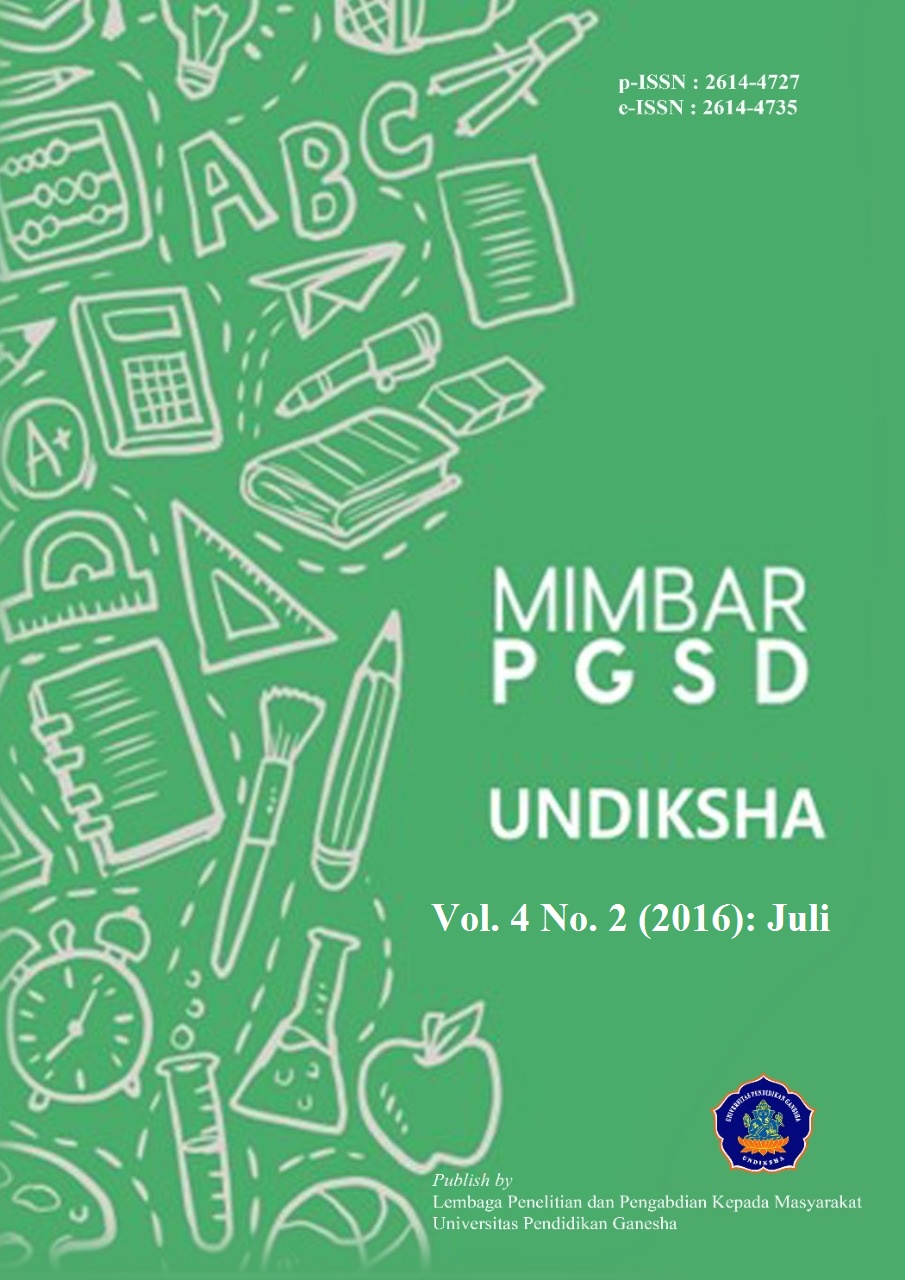PENGARUH MODEL PEMBELAJARAN SCRAMBLE BERBANTUAN MEDIA GAMBAR TERHADAP HASIL BELAJAR IPA DI SD
DOI:
https://doi.org/10.23887/jjpgsd.v4i2.8425Abstract
Penelitian ini bertujuan untuk mengetahui perbedaan hasil belajar IPA antara siswa yang mengikuti pembelajaran dengan model pembelajaran scramble berbantuan media gambar dan siswa yang mengikuti pembelajaran dengan model pembelajaran konvensional pada kelas IV di SD Negeri 1 Semarapura Tengah Kecamatan Klungkung tahun pelajaran 2016/2017. Jenis penelitian ini adalah penelitian eksperimen semu. Populasi penelitian ini adalah semua siswa kelas IV di SD Negeri 1 Semarapura Tengah Kecamatan Klungkung tahun pelajaran 2016/2017 yang berjumlah 95 orang. Sampel penelitian ini yaitu kelas IVA yang berjumlah 31 orang dan kelas IVC yang berjumlah 33 orang. Data hasil belajar IPA siswa dikumpulkan dengan instrumen tes berbentuk pilihan ganda. Data yang dikumpulkan dianalisis menggunakan analisis statistik deskriptif dan statistik inferensial (uji-t). Berdasarkan hasil analisis data, diperoleh thitung = 19,48 dan ttabel = 2,000 (pada taraf signifikansi 5%). Hal ini berarti bahwa thitung > ttabel, sehingga dapat diinterpretasikan bahwa terdapat perbedaan yang signifikan hasil belajar IPA antara siswa yang mengikuti pembelajaran dengan model pembelajaran scramble berbantuan media gambar dan siswa yang mengikuti pembelajaran dengan model pembelajaran konvensional. Dari rata-rata hitung, diketahui rata-rata kelompok eksperimen adalah 25,27 dan rata-rata kelompok kontrol adalah 17,13. Hal ini berarti bahwa rata-rata eksperimen lebih besar rata-rata kontrol, sehingga dapat disimpulkan bahwa penerapan model pembelajaran scramble berbantuan media gambar berpengaruh positif terhadap hasil belajar IPA siswa kelas IV di SD Negeri 1 Semarapura Tengah Kecamatan Klungkung.Kata Kunci : model pembelajaran scramble, media gambar, hasil belajar
This study aims to determine the difference between the IPA learning outcomes of students who take the learning-oriented scramble learning model helping picture media and students who follow learning with conventional learning models in the fourth grade at SD Negeri 1 Semarapura Tengah Klungkung District in the academic year 2016/2017. This research is a quasi experimental research. The population was in the fourth grade SD Negeri 1 Semarapura Tengah Klungkung in the academic year 2016/2017, amounting to 95 people. Samples of this research that IVA, amounting to 31 people and a IVC which amounts to 33 people. Math student learning outcomes data collected by instruments shaped test description. Data collected were analyzed using descriptive statistical analysis and inferential statistics (t-test). Based on the analysis of data, obtained t = 19,48 and table = 2.000 (at the 5% significance level). This means that tcount > ttable, so it can be interpreted that there are significant differences between the IPA learning outcomes of students who take the learning-oriented scramble learning model helping picture media and students who follow learning with conventional learning models. Of the arithmetic mean, median known experimental group was 25,27 and the average control group was 17,13. This means that on average a larger experiment the average control, so it can be concluded that the application of scramble learning model helping picture media problem-oriented influence on IPA learning outcomes fourth grade students in SD Negeri 1 Semarapura Tengah Klungkung.
keyword : scramble learning model, picture media, learning outcomes
Published
2016-09-26
How to Cite
., N. W. C., ., D. N. W., & ., D. I. M. T. S. M. (2016). PENGARUH MODEL PEMBELAJARAN SCRAMBLE BERBANTUAN MEDIA GAMBAR TERHADAP HASIL BELAJAR IPA DI SD. MIMBAR PGSD Undiksha, 4(2). https://doi.org/10.23887/jjpgsd.v4i2.8425
Issue
Section
Articles
License
Authors who publish with the Mimbar PGSD Undiksha agree to the following terms:
- Authors retain copyright and grant the journal the right of first publication with the work simultaneously licensed under a Creative Commons Attribution License (CC BY-SA 4.0) that allows others to share the work with an acknowledgment of the work's authorship and initial publication in this journal.
- Authors are able to enter into separate, additional contractual arrangements for the non-exclusive distribution of the journal's published version of the work (e.g., post it to an institutional repository or publish it in a book), with an acknowledgment of its initial publication in this journal.
- Authors are permitted and encouraged to post their work online (e.g., in institutional repositories or on their website) prior to and during the submission process, as it can lead to productive exchanges, as well as earlier and greater citation of published work. (See The Effect of Open Access)















